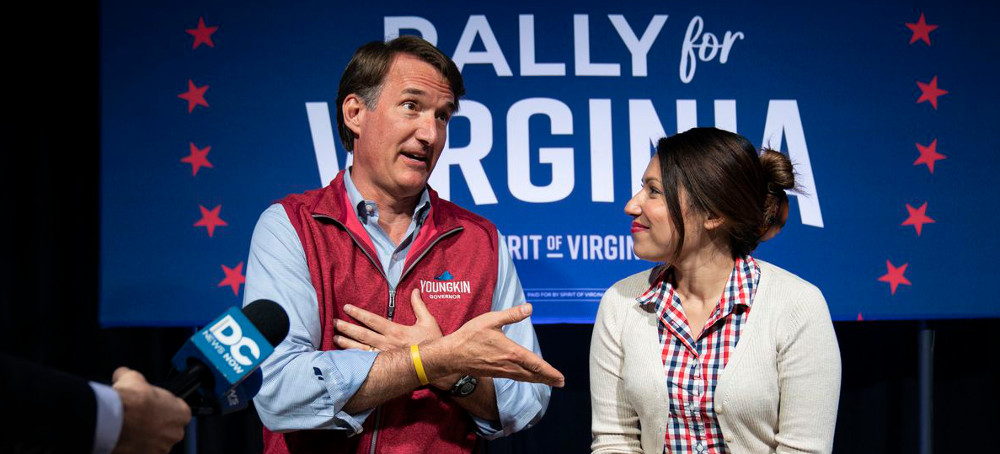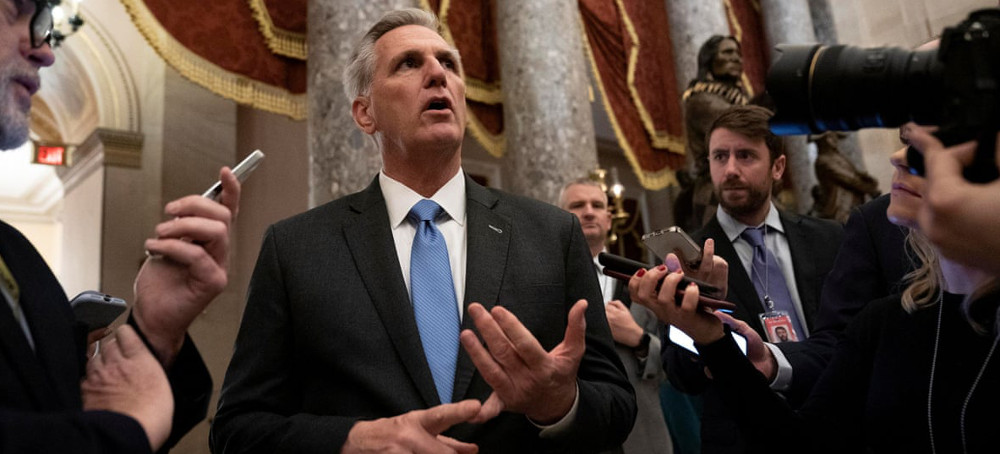Live on the homepage now!
Reader Supported News
In 2023, market fundamentalism is fostering authoritarianism—in the United States and abroad.
The second cataclysm is Russia’s war of aggression in Ukraine. The conflict shows no end in sight, and could escalate or produce even greater spillover effects. Either way, more disturbances to energy and food prices are all but assured. And, as if these problems weren’t vexing enough, there is ample reason to worry that the response from policymakers will make a bad situation worse.
Most importantly, the U.S. Federal Reserve may raise interest rates too far and too fast. Today’s inflation is largely driven by supply shortages, some of which are already in the process of being resolved. Raising interest rates therefore might be counterproductive. It will not produce more food, oil, or gas, but it will make it more difficult to mobilize investments that would help alleviate the supply shortages.
Monetary tightening also could lead to a global slowdown. In fact, that outcome is highly anticipated, and some commentators, having convinced themselves that combating inflation requires economic pain, have been effectively cheering on the recession. The quicker and deeper, the better, they argue. They seem not to have considered that the cure may be worse than the disease.
The global tremors from the Fed’s tightening could already be felt heading into winter. The United States is engaged in a 21st-century beggar-thy-neighbor policy. While a stronger dollar tempers inflation in the United States, it does so by weakening other currencies and increasing inflation elsewhere. To mitigate these foreign-exchange effects, even countries with weak economies are being forced to raise interest rates, which is weakening their economies further. Higher interest rates, depreciated currencies, and a global slowdown have already pushed dozens of countries to the edge of default.
Higher interest rates and energy prices will also push many firms toward bankruptcy, too. There have already been some dramatic examples of this, as with the now-nationalized German utility Uniper. And even if companies don’t seek bankruptcy protection, both firms and households will feel the stress of tighter financial and credit conditions. Not surprisingly, 14 years of ultra-low interest rates have left many countries, firms, and households over-indebted.
The past year’s massive changes in interest rates and exchange rates imply multiple hidden risks — as demonstrated by the near-collapse of British pension funds in late September and early October. Mismatches of maturities and exchange rates are a hallmark of under-regulated economies, and they have become even more prevalent with the growth of non-transparent derivatives.
These economic travails will, of course, fall hardest on the most vulnerable countries, providing even more fertile ground for populist demagogues to sow the seeds of resentment and discontent. There was a global sigh of relief when Luiz Inácio Lula da Silva defeated Jair Bolsonaro in Brazil’s presidential election. But let us not forget that Bolsonaro got almost 50% of the votes and still controls Brazil’s Congress.
Across every dimension, including the economy, the greatest threat to well-being today is political. Over half the world’s population lives under authoritarian regimes. Even in the United States, one of the two major parties has become a personality cult that increasingly rejects democracy and continues to lie about the outcome of the 2020 election. Its modus operandi is to attack the press, science, and institutions of higher learning, while pumping as much mis- and disinformation into the culture as it can.
The aim, apparently, is to roll back much of the progress of the past 250 years. Gone is the optimism that prevailed at the end of the Cold War, when Francis Fukuyama could herald “the end of history,” by which he meant the disappearance of any serious challenger to the liberal-democratic model.
To be sure, there is still a positive agenda that could forestall a descent into atavism and despair. But in many countries, political polarization and gridlock have pushed such an agenda out of reach. With better-functioning political systems, we could have moved much faster to increase production and supply, mitigating the inflationary pressures our economies now confront. After a half-century of telling farmers not to produce as much as they could, both Europe and the United States could have told them to produce more. The United States could have provided childcare — so that more women could enter the labor force, alleviating the alleged labor shortages — and Europe could have moved more quickly to reform its energy markets and prevent a spike in electricity prices.
Countries around the world could have levied windfall-profit taxes in ways that might actually have encouraged investment and tempered prices, using the proceeds to protect the vulnerable and to make public investments in economic resilience. As an international community, we could have adopted the Covid-19 intellectual-property waiver, thereby reducing the magnitude of vaccine apartheid and the resentment that it fuels, as well as mitigating the risk of dangerous new mutations.
All told, an optimist would say that our glass is about one-eighth full. A select few countries have made some progress on this agenda, and for that we should be grateful. But almost 80 years after Friedrich von Hayek wrote The Road to Serfdom, we are still living with the legacy of the extremist policies that he and Milton Friedman pushed into the mainstream. Those ideas have put us on a truly dangerous course: the road to a 21st-century version of fascism.
READ MORE  Not enough attention has been paid to the ways in which health professionals, and their diagnoses, can compound the trauma experienced by people who have been incarcerated. (photo: Ed Freeman/Getty)
Not enough attention has been paid to the ways in which health professionals, and their diagnoses, can compound the trauma experienced by people who have been incarcerated. (photo: Ed Freeman/Getty)
If an older man living on the streets becomes distressed when put in handcuffs, does he have a mental disorder?
As I review his chart, a pattern slowly emerges. An older Black man, Mr C has been arrested a few times over the years, typically for vague charges such as trespassing or disorderly conduct that are difficult to interpret. Is he truly menacing to people around him, or is he just trying to survive while living on the streets? He has little history of mental illness or substance use, except for an issue that seems to arise whenever he is brought to jail: he starts yelling that he doesn’t want to live any more.
When he’s incarcerated, Mr C becomes so distressed that he tears his clothing or sobs loudly throughout the night, to the point where other incarcerated people or custody staff get upset with him. He has been placed on suicide watch in padded jail cells, sent to emergency departments and seen by various mental health professionals, and usually these symptoms resolve within days after he enters jail or when he’s released.
I sigh, reading in his records the same diagnosis again and again, one that I’ve become simultaneously familiar and disillusioned with: “adjustment disorder”.
According to the latest edition of the Diagnostic and Statistical Manual of Mental Disorders, an adjustment disorder manifests in emotional or behavioral symptoms that arise alongside an identifiable stressor and typically resolve as the stressor disappears.
There are various criteria for the diagnosis of an adjustment disorder, and the process includes consideration of cultural and contextual factors that may shape patients’ symptoms. Nonetheless, health professionals tend to make this diagnosis when someone whose condition does not meet the criteria for another mental disorder demonstrates “marked distress that is out of proportion to the severity or intensity of the stressor”. I recall studying in medical school classic cases of adjustment disorder – for example, the case of a person who has difficulty functioning because of depression or anxiety after a divorce.
During medical school and residency, I learned that this diagnosis can sometimes be useful for clinicians, allowing us to name patients’ distress and use common language to characterize their clinical presentations after stressful life events. But in caring for incarcerated patients as a trainee and now as an attending physician, I’ve become troubled by the use of this diagnosis, among others. What does it mean to have a reaction that is “out of proportion” to being placed in shackles? Is there a “normal” way for a person to behave when stripped of freedom and locked in a cell?
If an older Black man living in poverty on the streets, surrounded by a society that provides him with little assistance and does not seem to care about him, becomes distressed when put in handcuffs, does he have a mental disorder? Should he “adjust” to this unjust reality, or does the disorder lie in the systems around him?
A great deal has been written about the dehumanizing nature of incarceration. Less attention has been paid to the ways in which health professionals, and the diagnoses we make, can compound the trauma experienced by people who have been incarcerated in jails and prisons. A woman locked in a cell for 23 or 24 hours a day might fall into such loneliness and despair that she cuts herself to get out of her cell and be sent to the hospital, whereupon physicians and nurses label her as “malingering” and promptly discharge her back to shackles and chains. When a man repeatedly acts out, yelling at staff or kicking his cell door, to protest against the conditions of his confinement, he will too often wind up with a medical chart filled with references to a “personality disorder” and notes on how challenging he is to deal with.
The language we use in medicine often fails to do justice to people who are put in cages. Incarcerated people have high rates of mental disorders, substance use disorders and other general medical conditions, yet they are usually not included in the research that guides diagnostic and treatment practices throughout the US. The field trials used to study the reliability of psychiatric diagnoses have generally not included people in jails or prisons.
The National Survey on Drug Use and Health, which provides estimates of the nationwide prevalence of mental and substance use disorders, does not include jail and prison populations in its data. As long as national medical organizations and government agencies exclude incarcerated people from these types of research, the language and statistics used by health professionals, policymakers and others will fail to accurately reflect the public health needs of US communities. Including incarcerated people in the studies and surveys that shape national health policy and healthcare practices is essential.
Beyond such additional research, health professionals need to consider not only the ways in which jails and prisons can affect people’s lives but also clinicians’ potential roles in exacerbating the traumatic effects of mass incarceration, poverty, racism and other social injustices. Clinicians should recognize that although diagnostic labels can help characterize patients’ health needs and guide treatment approaches, diagnoses can also be harmful, especially when applied haphazardly and without thoughtful consideration of patients’ life circumstances.
Meeting patients’ health needs, whether those patients are incarcerated or not, usually requires more than just medical diagnoses and treatments. Health professionals must also explore and address the social determinants of health that led to those health needs, in part by using our roles as trusted professionals to speak out against the social injustices that ravage the lives and health of our patients.
When I meet with Mr C, he is calm and friendly, and we discuss his experiences with incarceration. He explains that he does not belong in jail, which is why he becomes so distressed each time he ends up in one. We talk for some time about his life, discussing suicide safety planning, communication with his attorney and housing resources. He tells me he is no longer feeling suicidal, and since he’s heard he might be released soon, we agree not to start any medications for now. I offer to keep checking on him and ask him to submit a medical slip if he feels similar distress before our next appointment.
As I see other patients and then head back to my desk to write notes, I think about what to document as my diagnostic impression of Mr C. “Adjustment disorder” still feels wrong, as if we are waiting for him to accept his lot in life and adjust to a cycle of homelessness and incarceration. I could write “diagnosis deferred”, but that feels unhelpful and incomplete. Perhaps I could write “distress related to incarceration”, which is not a mental disorder but seems like a more accurate and humane description of Mr C’s circumstances.
I return to my desk and log into the electronic health record. When I click on Mr C’s chart, his encounter status has changed to discharged. He has already been released from custody, and I’m left to update the “problem list” in his chart, where so many problems are listed as though they are his alone.
READ MORE  Virginia governor Glenn Youngkin and Yesli Vega, Republican candidate for northern Virginia's Seventh Congressional District, speak to reporters after a campaign event at Locust Shade Park on November 7, 2022, in Triangle, Virginia. (photo: Sarah Silbiger/Getty)
Virginia governor Glenn Youngkin and Yesli Vega, Republican candidate for northern Virginia's Seventh Congressional District, speak to reporters after a campaign event at Locust Shade Park on November 7, 2022, in Triangle, Virginia. (photo: Sarah Silbiger/Getty)
The future of abortion rights in the state could hinge on whether Democrat Aaron Rouse wins a special election to the state Senate.
As of Wednesday afternoon, Democrat Aaron Rouse, a former National Football League player and former Virginia Beach City Council member, held a narrow lead over his Republican opponent Kevin Adams in a special election to fill a vacancy in the Virginia Senate’s Seventh District. Though Rouse has already declared victory, there are some absentee ballots yet to be counted that could erase his less than 350-vote lead. If Rouse prevails, Democrats would have a 22-18 edge in the chamber, which commenced its annual session on Wednesday.
The race may decide whether state Republicans can take up additional restrictions on abortion this year. Though Democrats make up the majority of the Senate, their margin would only be 21-19 in the chamber if Adams wins. Adams has said that he supports a 15-week abortion ban proposed by Virginia Republican Gov. Glenn Youngkin. And Democratic state Sen. Joseph D. Morrissey (D-Richmond) is openly anti-abortion and has said that he would keep an “open mind” when it comes to further restrictions on abortion. That means the chamber could potentially be tied on the issue, and Republican Lt. Gov. Winsome Sears, also an anti-abortion politician, would cast the tiebreaking vote.
Virginia is one of many states considering further restrictions on abortion this year. Bills that would ban abortions after fetal cardiac activity is detected in Nebraska, that would prevent local governments from funding employees seeking an abortion through their health plans or reimbursement for out-of-state travel in Tennessee, and that would ban abortion before 12 weeks of pregnancy in North Carolina are among those on the table. The Guttmacher Institute, a pro-abortion rights think tank, found that 24 states were likely to ban abortion or had already done so heading into 2023.
That’s made abortion a key issue for Democrats in state legislative races, including for Rouse. He ran multiple TV ads focusing on the issue and received more than $100,000 from Planned Parenthood Advocates of Virginia this cycle.
“When I was in the NFL, my job was to be the last line of defense. Right now, that’s what we need in Richmond,” he says in one December ad. “Women’s rights are on the line, but I’ll never back down.”
Ahead of Rouse’s seeming win, the threat to abortion access in the state was very real. Currently, Virginia allows abortions up to about 26 weeks of pregnancy and, after that, only in cases where three doctors attest that the pregnant person’s life is at risk. Youngkin’s proposal for a 15-week ban includes exceptions for rape, incest, and to save the pregnant person’s life. Democrats have argued that the governor’s proposal could result in prison time for women and doctors, but Youngkin’s office has dismissed that framing as “political posturing” and said that he will not imprison women.
Youngkin has also proposed barring state Medicaid from covering abortions when a fetus has an “incapacitating” physical or mental deformity, and preventing state funds from being used to support abortion services.
Those measures might pass in the Republican-controlled state House. But if Rouse does win, that would likely foreclose the possibility of a tie in the state Senate and doom Youngkin’s proposal for now.
What’s next for abortion rights in Virginia
Rouse’s apparent victory would maintain the status quo on abortion rights in Virginia, but only temporarily.
Democrats could be down a vote in the state Senate if Sen. Jennifer McClellan (D-Richmond) steps down, reopening the possibility of a tie. She’s widely favored to win a special election to fill a vacant federal congressional seat in February, but she told the Virginia Mercury that she’s confident that any votes on abortion legislation will conclude before she’d have to resign and that the Democratic caucus will hold strong against further abortion restrictions. It’s not clear whether there would be time to hold a special election to fill that seat, given that it would have to happen at least 55 days before the June 20 primary.
Then, in November, all 140 state legislative seats are up for grabs, and if Republicans can defend their majority in the state House and net even just one seat in the state Senate, Youngkin’s proposal, or even more extreme abortion restrictions, such as a proposed ban after 12 weeks of pregnancy, could be back on the table. Youngkin has previously said that he would “gleefully” sign “any bill [to protect life] that comes to my desk” — not just one of his own devising.
At the same time, abortion rights groups in the state are trying to further protect abortion rights. REPRO Rising Virginia, an abortion rights group, is pushing for a state constitutional amendment that would establish a right to reproductive freedom and to make pregnancy decisions without discrimination, as well as protect abortion providers and their patients from being criminalized.
Though other states have successfully passed similar amendments enshrining abortion rights in their state constitutions over the last year, the amendment probably won’t happen in Virginia anytime soon, especially so long as Republicans control the state House. Any amendment would have to pass the legislature two years in a row with an intervening state House election before going to the voters.
Virginia is a top priority for Democrats in 2023
If Rouse wins, that would bode well for Democrats who are looking to take back the Virginia House of Delegates and defend their state Senate majority this fall.
They only need three more seats to win the House, and if they succeed in widening their majority in the state Senate with a win in the Seventh District, they would have a cushion heading into November, when a new electoral map drawn by a court-appointed special master will shake up the dynamics for Democratic incumbents. The maps are thought to slightly advantage Democrats, but some Democratic lawmakers have argued that the new map should have delivered a bigger edge to their party and unfairly pits incumbents against each other.
“Virginia is a huge priority,” said Jessica Post, president of the Democratic Legislative Campaign Committee, the fundraising arm of the Democratic Party dedicated to state legislative races. “We need to do a lot of work, especially with Democratic incumbents, to introduce them to their new constituents and [ensure] they have a great record to run on.”
Democrats anticipate that Youngkin will spend significantly in state legislative races ahead of a rumored 2024 presidential bid, which he has not yet ruled out. A big win this year could help to position him as a figure akin to Florida Republican Gov. Ron DeSantis or Michigan Democratic Gov. Gretchen Whitmer, who are both seen as having a future in national politics in part because of their ability to hold onto and deepen majorities in their state legislatures.
“We think that Youngkin, because he’s both personally wealthy and he has a great ability to raise money nationally, is going to try to use this as a proving ground,” Post said. “We’re hoping that we can find the national interest in Virginia that we’ve been able to find in prior cycles and humble Youngkin and manage some of his ambitions in the state.”
READ MORE  Taylor Dudley, a 35-year-old U.S. Navy veteran, was released from Russian custody Thursday after nearly a year of negotiations. (photo: Jonathan Franks/CNN)
Taylor Dudley, a 35-year-old U.S. Navy veteran, was released from Russian custody Thursday after nearly a year of negotiations. (photo: Jonathan Franks/CNN)
Taylor Dudley was released at a border crossing with Poland. It appears he was not part of a prisoner swap.
Taylor Dudley, 35, of Michigan, had been held since April in the Russian province of Kaliningrad, located between Poland and Lithuania. He was released at a border crossing with Poland and was traveling to the United States with a team working for former New Mexico governor Bill Richardson, according to a statement from his center, which negotiates for the release of hostages and prisoners abroad.
U.S. officials confirmed the release. It appeared that the U.S. government did not reciprocate with the release of any Russian prisoners, as it has in the past, including with professional basketball player Brittney Griner, who was exchanged for convicted arms trafficker Viktor Bout.
A State Department spokesman indicated that Dudley had been deported from Russia, another signal that his release was not equivalent to earlier swaps and may have little bearing on the case of another U.S. citizen in Russia, Paul Whelan, whom the Biden administration has been trying to free through a prisoner exchange.
“Generally, when a U.S. citizen is deported, the State Department may provide assistance to help facilitate the return of the U.S. citizen to the United States,” the spokesman said, speaking on the condition of anonymity to describe internal procedures.
Another U.S. official described the release as the result of consular negotiations and was unaware of any role played by outside parties.
“The U.S. Government has no information about a role played by any outside actor in this case. The U.S. Government is focused on providing consular services to Americans. We are all grateful to our embassies in Moscow and Warsaw for their long-standing work on this case,” the official said, speaking on the condition of anonymity to describe internal negotiations.
Dudley reportedly had been attending a music festival in Poland when he was detained. It was not clear why he crossed the border into the Russian province.
CNN first reported Dudley’s release.
READ MORE  Kevin McCarthy, the new Republican speaker of the House. (photo: Sarah Silbiger/Reuters)
Kevin McCarthy, the new Republican speaker of the House. (photo: Sarah Silbiger/Reuters)
ALSO SEE: Talk of Prosecuting Women for Abortion Pills Roils Antiabortion Movement
Bills not expected to advance in Senate but underscore Republican majority’s legislative priorities ahead of 2024 election
Voting mostly along party lines, Republicans first approved a bill that would compel doctors to provide care for an infant who survives an attempted abortion – an occurrence that is exceedingly rare.
After its passage, Republicans broke into applause on the House floor as the bill’s sponsor, congresswoman Ann Wagner, a Republican of Missouri, waved the text of the legislation in celebration.
Democrats, several of them wearing white in protest, remained silent. However, on the measure, two Texas Democrats broke with the party: the congressman Henry Cuellar, who opposes abortion, supported it while his colleague Vicente González voted present.
The House also passed a non-binding resolution condemning attacks on pregnancy crisis centers, with the support of all Republicans and three Democrats.
The proposals, among the first moves made by Republicans’ new, narrow House majority, are unlikely to be taken up by the Democratic-controlled Senate. But their passage will provide the Republican majority an opportunity to draw a sharp contrast with Democrats on the issue of abortion ahead of the 2024 elections.
“I am proud that Republicans are following through on the promises that we made to the American people,” the majority leader, Steve Scalise, the second-highest-ranking House Republican and a staunch anti-abortion advocate, told reporters this week. “All life is sacred and must be protected.”
Anti-abortion groups have long pushed so-called “born alive” legislation similar to the version under consideration in the House, which could carry a prison sentence of up to five years for medical workers.
Critics, including medical professionals, say such measures are based on distortions and misinformation about what is often an extremely painful and often unwanted decision to end a pregnancy. Abortions after the point of viability, which is defined as about 23 weeks, are extremely uncommon, according to federal and state data. In the rare instances they do happen, they often involve serious fetal abnormalities or risks to the life of the mother.
Moreover, opponents say newborns are already protected by a bipartisan law passed in 2002, which established full legal rights for infants born at any stage of development.
In a floor speech, Jerry Nadler, a Democrat of New York, said the measure “does nothing new to protect infants” but neither was it “harmless”.
“The bill directly interferes with a doctor’s medical judgment and dictates a medical standard of care that may not be appropriate in all circumstances, which could, in fact, put infants’ lives at greater risk,” Nadler said.
Abortion rights advocates also reacted to the bill. “Let’s be clear: doctors are already required to provide appropriate medical care by law,” Jacqueline Ayers, a senior vice-president at the Planned Parenthood Federation of America, said in a statement. “This is not how medical care works. It’s wrong, irresponsible, and dangerous to suggest otherwise.”
But Wagner, who has repeatedly championed the measure, argued, without evidence, that additional protections for infants born after abortion attempts were necessary because “many of these sweet little ones are denied the medical care they need to survive and thrive”.
Public support for abortion rights has climbed since the supreme court eliminated the constitutional right to an abortion last summer. In November, voters punished Republicans for building the conservative court that overturned Roe. Despite rampant inflation and Joe Biden’s low approval ratings, Democrats defied expectations in November, keeping control of the Senate and limiting Republican gains in the House, where their razor-thin majority is already proving to be a challenge.
Efforts to restrict abortion have even been met with fierce resistance in traditionally Republican states. In Montana, a conservative western state, voters rejected an initiative related to infants born after attempted abortions that is similar to the one House Republicans passed on Wednesday.
Abortion remains a top concern among conservative Republicans and anti-abortion activists alarmed by the backlash to the supreme court decision. Yet the early focus on abortion has given some Republicans in swing districts cause for concern.
“We learned nothing from the midterms if this is how we’re going to operate in the first week. Millions of women across the board were angry over overturning Roe v Wade,” Nancy Mace, a Republican from South Carolina, told reporters on Capitol Hill on Tuesday.
Noting that the bills had little chance of becoming law, she called the move “tone-deaf” and said Republicans were merely “paying lip-service to life”.
“If you want to make a difference and reduce the number of abortions with a Democratic-controlled Senate, the No 1 issue we should be working on is access to birth control,” she said. Nevertheless, Mace voted for the bills alongside her party.
Republicans also advanced a resolution, which carries no legislative weight, condemning violence against “pro-life facilities, groups and churches” which drew Democratic opposition because of its failure to address the threats targeting women’s healthcare clinics and abortion providers.
“By ignoring these acts of violence, Republicans are sending a very dangerous message that will only embolden the extremists behind them,” said Diana DeGette, a Democrat of Colorado and co-chair of the House Pro-Choice Caucus.
Speaking on the House floor ahead of the vote, DeGette urged Republicans instead to adopt a counter-resolution that would condemn acts of political violence in any form.
Republicans, arguing in favor of the resolution, said anti-abortion groups had become targets of political violence since the supreme court’s June decision, and denounced the department of justice’s response to these attacks as inadequate.
“This resolution is very simple and its language is clear,” said Jim Jordan, a Republican of Ohio, who has been critical of what he says is evidence of political bias within federal law enforcement against anti-abortion groups. “It also calls upon the Biden administration to take action now to bring the perpetrators to justice. Who could be opposed to that?”
In a statement, the Senate majority leader, Chuck Schumer, affirmed that the bills were “doomed” in the Senate, where he said Democrats would act as a “firewall against this extreme anti-choice Maga Republican agenda”.
“Just months after a historically disappointing midterm election, the Maga Republican-controlled House is putting on full display their truly extreme views on women’s health with legislation that does not have the support of the American people,” Schumer said ahead of the House vote. “Once again, Republicans are proving how dangerously out of touch they are with mainstream America.”
Reproductive rights activists won another political victory this week in Virginia, where abortion was at the center of a closely watched state senate race. Democrats flipped the seat, a result that will probably prevent the state legislature from enacting a 15-week abortion ban backed by the state’s conservative governor, Glenn Youngkin.
READ MORE  President Donald Trump and North Korea's leader Kim Jong-un stand on North Korean soil while walking to South Korea in the Demilitarized Zone on June 30, 2019, in Panmunjom, Korea. (photo: Brendan Smialowski/AFP)
President Donald Trump and North Korea's leader Kim Jong-un stand on North Korean soil while walking to South Korea in the Demilitarized Zone on June 30, 2019, in Panmunjom, Korea. (photo: Brendan Smialowski/AFP)
In a new section of his book on Trump's presidency, The New York Times' Michael Schmidt details John Kelly’s tenure as White House chief of staff from July 2017 to January 2019.
Trump's alleged comments, reported for the first time in a new afterword to a book by New York Times Washington correspondent Michael Schmidt, came as tensions between the U.S. and North Korea’s Kim Jong-un escalated, alarming then-White House chief of staff John Kelly.
The new section of "Donald Trump v. the United States," obtained by NBC News ahead of its publication in paperback Tuesday, offers an extensive examination of Kelly’s life and tenure as Trump's chief of staff from July 2017 to January 2019. Kelly previously was Trump's secretary of homeland security. For the account, Schmidt cites in part dozens of interviews on background with former Trump administration officials and others who worked with Kelly.
Eight days after Kelly arrived at the White House as chief of staff, Trump warned that North Korea would be "met with fire and fury and frankly power, the likes of which this world has never seen before." When Trump delivered his first speech to the U.N. General Assembly in September 2017, he threatened to "totally destroy North Korea" if Kim, whom he referred to as "Rocket Man," continued his military threats.
Later that month, Trump continued to goad North Korea through his tweets. But Kelly was more concerned about what Trump was saying privately, Schmidt reports.
"What scared Kelly even more than the tweets was the fact that behind closed doors in the Oval Office, Trump continued to talk as if he wanted to go to war. He cavalierly discussed the idea of using a nuclear weapon against North Korea, saying that if he took such an action, the administration could blame someone else for it to absolve itself of responsibility," according to the new section of the book.
Kelly tried to use reason to explain to Trump why that would not work, Schmidt continues.
"It’d be tough to not have the finger pointed at us," Kelly told the president, according to the afterword.
Kelly brought the military’s top leaders to the White House to brief Trump about how war between the U.S. and North Korea could easily break out, as well as the enormous consequences of such a conflict. But the argument about how many people could be killed had "no impact on Trump," Schmidt writes.
Kelly then tried to point out that there would be economic repercussions, but the argument held Trump’s attention for only so long, according to the afterword.
Then, Trump "would turn back to the possibility of war, including at one point raising to Kelly the possibility of launching a preemptive military attack against North Korea," Schmidt said.
Kelly warned that Trump would need congressional approval for a pre-emptive strike, which "baffled and annoyed" Trump, according to the afterword.
Trump tweeted in early January 2018: "North Korean Leader Kim Jong Un just stated that the 'Nuclear Button is on his desk at all times.' Will someone from his depleted and food starved regime please inform him that I too have a Nuclear Button, but it is a much bigger … more powerful one than his, and my Button works!"
Schmidt also writes that it was well-known among senior U.S. officials for several decades that North Korea sought to spy on U.S. decision-makers. So White House aides were alarmed "that Trump would repeatedly talk on unclassified phones, with friends and confidants outside the government, about how he wanted to use military force against North Korea."
Schmidt writes that there is no indication North Korea had a source in the White House, but he said it "was well within the realm of American intelligence assessment" that it could have been listening to Trump’s calls.
"Kelly would have to remind Trump that he could not share classified information with his friends," Schmidt writes.
According to the new section, Kelly came up with a plan he believes ultimately prompted Trump to dial back the rhetoric in spring 2018: appealing directly to Trump’s "narcissism."
Kelly convinced the president he could prove he was the "greatest salesman in the world" by trying to strike a diplomatic relationship, Schmidt writes, thereby preventing a nuclear conflict that Kelly and other top military leaders saw as a more immediate threat than most realized at the time.
The situation with North Korea consumed Kelly almost immediately upon his taking the job at the White House, which he had not actually committed to do before Trump tweeted that the post was his, according to the new section.
“Holy s--- — oh, I gotta call Karen,” Kelly said, referring to his wife, according to the afterword.
"Three days later, on Monday morning, Kelly met with his aides in a large conference room at a Department of Homeland Security office building a few blocks from the White House. Kelly was solemn. 'This is a great job,' he said, referring to the cabinet position he was leaving. 'That’s not a great job. But the president has asked me to do it.'"
READ MORE  Numerous cougar sightings were reported east of the Mississippi River last fall, encounters that have become more frequent in recent years. (photo: John Burcham/The New York Times)
Numerous cougar sightings were reported east of the Mississippi River last fall, encounters that have become more frequent in recent years. (photo: John Burcham/The New York Times)
Cougars once had the run of the continent, ranging far and wide. But they were virtually eliminated in the Eastern United States by the early 1900s (except for a small population that survives in Florida), victims of bounty hunting and habitat loss. In recent decades, their numbers in the Western United States, where they were also once targeted for eradication, have rebounded, and now these big cats, also known as mountain lions, panthers and pumas, are slowly moving east.
Newly published research by me and 12 colleagues has pinpointed over a dozen landscapes large enough to sustain cougars indefinitely in states that border or are east of the Mississippi. Their return would most likely result in healthier forests, safer roadways, less zoonotic disease and, in turn, healthier human communities.
This will all depend, of course, on whether we can learn to coexist with these top-tier carnivores. As a scientist who has studied these cats for years, I’m confident that we can. But it will require planning that must begin now, new state policies, public outreach, and education and support from the public for a creature that was once purposefully pushed toward oblivion.
Our team of researchers explored the habitat potential for cougars using factors important for cougar survival, like forest cover, distance to development and highways, human population density and how people perceive wildlife. Our research, which was published online last week in the journal Biodiversity and Conservation, shows there is plenty of room for them.
Results revealed 17 areas in the Upper Midwest, Ozarks, Appalachia and New England, each at least or nearly twice the size of Yosemite National Park, that fit the bill. Of these, 13 had enough space to support long-term cougar populations. Another study separate from ours showed similar results.
It’s clear the Eastern United States has the space, and the right type of space, for cougars to exist comfortably — if we allow it. Our growing understanding of the cats and the benefits they provide to ecosystems, other wildlife and people should inform that decision.
Wary of humans, cougars feed mainly on deer and smaller prey. The risk of a cougar attack — on people or domestic animals — is extremely low, and almost zero with pragmatic precautions. Fewer than two dozen people have been killed by cougars in North America in the past 100 years. (Males range in size from 120 to 180 pounds, depending on where they live; females are much smaller, ranging from 70 to 110 pounds.) Scientists estimate a recolonization of the Eastern United States by cougars could reduce deer-vehicle collisions by 22 percent over 30 years, averting 21,400 human injuries, 155 human fatalities and over $2 billion in costs. The return of cougars to South Dakota in the 1990s, for example, reduced costs of deer-vehicle collisions by an estimated $1.1 million annually.
We now know that large carnivores greatly benefit entire ecosystems and hold those ecosystems together. Cougars interact with nearly 500 species, from elk to beetles. Evidence suggests these cats help control chronic wasting disease among deer and other wildlife diseases.
Coexisting with cougars will require education around perceived versus actual threats, what benefits the cats bring and how to be around them safely. This is especially important for people living on the front lines of a cougar comeback, like rural ranchers and small-livestock owners.
Eastern states must adopt policies that protect cougar habitats and address broader implications of living alongside these cats so that ones like those spotted in Illinois and Minnesota have somewhere to land. In part, this means state wildlife plans with protections that list the species as endangered, threatened or of greatest conservation need until their numbers are sufficient to reduce these protections.
Addressing the legitimate concerns of communities sharing habitat with cougars will help to ensure the successful, long-term existence of the species in the Eastern United States.
It took nearly 20 years for cougars to expand eastward across just 100 miles of human-dominated landscape between the Black Hills of South Dakota and the Pine Ridge area of Nebraska. Without actively reintroducing cougars in the East, it could take decades for the cats to do it themselves.
We could wait for the cats to make their way east or we could choose to support the cougars’ return by re-establishing them there, a prospect I never thought would be possible during my formative years as a scientist tramping through New England forests. Our research, however, points to areas in the Northeast that would support self-sustaining populations. These places are characterized by lower livestock densities than other areas we identified and are complemented by local people who view wildlife as more than a resource to be exploited.
However we proceed, these big cats are on their way back to their Eastern haunts. Midwest sightings are increasing, with hundreds of cougars spotted east of established populations over the past three decades. These trailblazers are often young males like the “Connecticut Cat,” which traveled 1,700 miles from the Black Hills of South Dakota to the Northeast in search of unclaimed territory and a mate. Females will follow more slowly, so we are unlikely to see frolicking cougar kittens in the East anytime soon.
Our new research offers reason for optimism that these big cats will have places to live when they return. There is still ample space for them to thrive in the East. We should take steps now to secure their future.
Follow us on facebook and twitter!
PO Box 2043 / Citrus Heights, CA 95611


